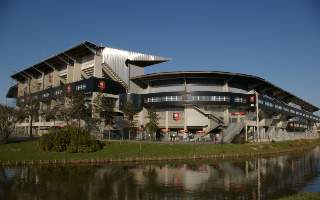Orange Vélodrome (Stade Vélodrome)
| Capacity | 67 394 |
|---|---|
| 1,263 (in 80 skyboxes) (VIP seats) | |
| 371 (Disabled seats) | |
| 18,851 (Tribune Jean Bouin) | |
| 22,321 (Tribune Ganay) | |
| 12,937 (Virage Sud) | |
| 12,947 (Virage Nord) | |
| Country | France |
| City | Marseille |
| Clubs | Olympique de Marseille |
| Inauguration | 13/06/1937 (Olympique Marseille - FC Torino, 2-1) |
| Construction | 25/04/1935 - 05/1937 |
| Renovations | 1971, 1983, 1997-1998, 2011-2014 |
| Record attendance | 61,846 (Olympique Marseille - FC Toulouse, 19/10/2014) |
| Cost | €268 million (2011-2014) |
| Design | Henri Ploquin (1935), Jean-Pierre Buffi (1997), SCAU (2011) |
| Address | 3, Boulevard Michelet, 13008 Marseille |
Advertisement
Orange Vélodrome – stadium description
Why was the construction of Stade Vélodrome decided?
In 1928, the authorities of Marseille expressed a desire to build a municipal stadium because Stade de l'Huveaune belonged to the Olympique de Marseille club. The first project was rejected by the city council in 1930 due to excessive costs. The 1938 FIFA World Cup, organized in France, reignited interest in constructing a new sports facility. In 1935, Parisian architect Henri Ploquin, who had previously worked on the municipal stadium in Vichy, proposed the construction of an Olympic stadium that would include an athletics track and a sports hall. Due to budgetary constraints, only the stadium itself was ultimately built.
On April 28, 1935, the then-mayor of Marseille, Dr. Georges Ribot, laid the foundation stone for the construction of Stade Vélodrome. The stadium was built on the site of the former Turcat-Méry automotive factories, located between the Saint-Giniez and Sainte-Marguerite districts in the south of the city. The construction work lasted 26 months, during which 25,000 m³ of earth was moved and 240 ten-meter foundation piles were driven in.
When was the inauguration of Stade Vélodrome?
Stade Vélodrome was officially inaugurated on June 13, 1937, by the then Undersecretary of State for Sports, Léo Lagrange, in the presence of nearly 30,000 spectators. To mark the occasion, a grand sports day was organized, including an athletics meet and a cycling race on specially prepared tracks. The first winner in the new stadium was Marseille cyclist Antoine Pugliesi, who triumphed in the Gustave-Ganay criterion. The highlight of the ceremony was a friendly football match between Olympique de Marseille and the Italian club Torino FC. The match ended in a 2-1 victory for the home team, with Émile Zermani scoring the first goal in the new stadium. With the inauguration of Stade Vélodrome, OM officially moved from its former stadium, Stade de l'Huveaune.
What was the first renovation of Stade Vélodrome like?
In 1970, Stade Vélodrome underwent its first modernization. The old floodlights in the Ganay and Jean-Bouin stands were replaced with four 60-meter-high lighting masts, allowing for night matches. In March 1971, the stadium's capacity was increased by about 6,000 seats by reducing the cycling track and removing the cinder athletics track. After this renovation, Vélodrome could accommodate 55,000 spectators, including standing areas.
How was Stade Vélodrome renovated for the World Cup?
For the 1998 FIFA World Cup in France, a comprehensive renovation of Stade Vélodrome was announced in March 1995, aiming to increase its capacity to 60,000 seats. The modernization project was entrusted to the Chagnaud - Travaux du Midi / Buffi consortium. The renovation cost 391.9 million francs, funded by the state and local authorities. The renovation was extensive, preserving only part of the Jean-Bouin stand (including the stadium facade) and the upper sections of the Ganay stand. The construction involved pouring 20,000 m³ of concrete, building 32 km of stands, 400 stair flights, and installing 650 tons of steel structures and 1,500 tons of reinforcements.
The renovation sparked controversy, mainly due to the lack of a roof, which affected the acoustics and comfort of the fans. Initially, it was planned to limit capacity to 40,000 for league matches and use the full 60,000 seats only for major games, but this idea was abandoned as OM regularly attracted over 50,000 spectators. The new Stade Vélodrome was inaugurated on December 4, 1997, during the draw ceremony for the 1998 World Cup groups. The stadium hosted seven matches of the tournament.
Why was Stade Vélodrome criticized?
In the 2000s, the stadium did not undergo major changes. Despite its history, Stade Vélodrome was often criticized by Marseille residents for its architecture—the lack of a roof, poor acoustics, and open
configuration. Coach Rolland Courbis even called it L'Enrhumeur
(which can be translated as the cold-maker
). Since 2003, various modernization projects had been proposed, including a 2005 plan to build a roof and increase capacity to 80,500 seats, but none were realized.
Only France's bid to host UEFA Euro 2016 forced Marseille authorities to take concrete action to modernize the stadium in line with UEFA requirements.
How was Stade Vélodrome renovated for Euro 2016?
On June 21, 2010, the city unveiled a renovation project for Stade Vélodrome, prepared for Euro 2016. The project was entrusted to Bouygues Construction through its subsidiary Arema, with a total cost of €267 million. Funding came from various sources, including Bouygues Construction investing €100 million, the city of Marseille contributing €40 million, the Bouches-du-Rhône department €30 million, and additional funding from the French government and local organizations.
The redesign was led by SCAU Architecture, with key architects including Maxime Barbier, Bernard Cabannes, Luc Delamain, François Gillard, Michel Macary, and Aymeric Zublena. The renovation aimed to transform the stadium into a UEFA-compliant football venue and achieve five-star stadium
classification (now replaced by Category 4). The most significant change was the addition of a roof, weighing 5,500 tons—80% of the Eiffel Tower's weight. The stadium's capacity increased to 67,394 seats.
Construction began in March 2011 and was completed in the summer of 2014. The stadium was officially reopened on October 16, 2014, with over 67,000 covered seats. The total renovation cost, re-evaluated by the Court of Auditors at €551 million, included maintenance expenses until 2045.
What does Stade Vélodrome look like?
The stands were designed to provide comfort and excellent visibility for spectators. They are arranged on three levels, with upper sections added during the renovation, as well as new, more spacious VIP areas. The most significant changes affected the west and east stands, which were rebuilt from scratch with a modern seating layout and improved visibility. The Gustave Ganay Stand offers 22,398 seats, including 1,882 VIP seats in exclusive boxes. The Jean Bouin Stand has 12,300 seats. The north stand, also known as the Virage Nord Patrice de Peretti, accommodates 13,800 spectators. Similarly, the south stand, called Virage Sud Chevalier Roze, also has 13,800 seats. The central feature of the stadium is now its roof, an impressive umbrella
structure.
From the outside, the stadium looks impressive, with large, streamlined shapes emphasizing its modern character. One of its most striking elements is the monumental roof, which, combined with the bright façade, makes the structure stand out.
What is Stade Vélodrome used for?
Since 1937, Stade Vélodrome has been the home of the Olympique de Marseille football club. Additionally, the stadium regularly hosts rugby matches, both domestic and international. While rugby union (rugby XV) is now predominant, the first rugby matches played here were in the rugby league (rugby XIII) format. The first rugby league match featuring the French national team took place on January 16, 1938, when Australia defeated France in front of 24,000 spectators. Stade Vélodrome also has roots as a cycling track.
What major sporting events have taken place at Stade Vélodrome?
Stade Vélodrome hosted matches in the FIFA World Cup in 1938 and 1998, as well as the UEFA European Championship in 1960, 1984, and 2016. The stadium has also hosted Olympic football tournament matches and Challenge des Champions games.
To date, the stadium in Marseille has hosted fifteen matches of the French men’s national football team. It is the stadium outside the Paris region that has hosted the most matches for Les Bleus.
Apart from the World Cup and European Championship games, France has played nine friendly and qualifying matches there. The French women's national team has also played three matches at Vélodrome.
The stadium has hosted multiple Rugby World Cup matches in different formats, Top 14 semi-finals, Challenge Européen finals, the Six Nations Tournament, and the Champions Cup final. In 2026, Stade Vélodrome will once again host two Top 14 semi-finals.
Until 1967, the stadium was the finish line for ten Tour de France stages. In 1972, it hosted the Track Cycling World Championships. On July 22, 2017, the stadium once again hosted the start and finish of a time trial stage in the Tour de France, serving as the penultimate stage before the Paris finale. However, attendance was disappointing despite free entry, as Marseille residents preferred to watch the cyclists on the city streets. For several consecutive years, Vélodrome was the finishing location for the Grand Prix La Marseillaise, including the 2022 edition.
The stadium has also hosted other events, such as Holiday on Ice figure skating performances in the 1950s.
What non-sporting events have taken place at Stade Vélodrome?
Since the 1980s, Stade Vélodrome has been a concert venue. Artists who have performed there include Julio Iglesias, Joan Baez (1983), Metallica (1984), Pink Floyd (1989), The Rolling Stones (1990, 2003, and 2018), U2 (1993), Johnny Hallyday (2000, 2003, 2006, and 2009), Luciano Pavarotti (2002), The Police (2008), AC/DC (2009 and 2016), Paul McCartney (2015), Céline Dion (2017), Soprano (2017, 2019, 2022), Muse (2019, 2023), Beyoncé (2023), Bruce Springsteen & E Street Band (2024), and Rammstein (2024).
On July 16, 2009, during preparations for a Madonna concert, a tragic accident occurred when one of the four cranes used to lift the stage structure failed. The 60-ton roof collapsed, crushing the crane and causing the deaths of two people while injuring ten others.
Vélodrome has also been used for political rallies, such as speeches by Communist leader Georges Marchais on April 11, 1981, and far-right leader Jean-Marie Le Pen on April 17, 1988. Since then, Marseille’s mayor Jean-Claude Gaudin has opposed using the stadium for political purposes, emphasizing that it should remain a place of consensus, sports, culture, celebration, and unity among all communities. Every year, at the end of the school year, thousands of students from Marseille gather at the stadium for the traditional Fête des Écoles, a performance prepared by children throughout the academic year.
The stadium has also been a filming location for movies and music videos. The film Stillwater features a scene during an OM vs. Lyon match in 2019, and Taxi 4 includes a scene featuring Djibril Cissé. Music videos such as Santa Maradona by Mano Negra (1994), Halla, Halla by Soprano (2007), and Bande Organisée (2020) were also shot at the stadium.
What is the attendance record at Stade Vélodrome?
The highest attendance in Stade Vélodrome’s history occurred during the 2023-2024 Top 14 final between Stade Toulousain and Union Bordeaux Bègles on June 28, 2024, with 66,760 spectators.
As for football, the record attendance was set on February 15, 2025, when 66,199 fans attended the Olympique de Marseille vs. Saint-Étienne match.
How does Stade Vélodrome compare to other Ligue 1 stadiums?
Advertisement
Pictures
-

09.2014 © SCAU 
09.2014 © Le Nouveau Stade Vélodrome 
25.09.2014 © Design_Ex (cc: by-nc) 
31.01.2016 © lajoliette2010 Paul Pittorino 
23.05.2016 © lajoliette2010 Paul Pittorino 
11.11.2015 © Youn Hamelat 
26.07.2014 © Objet Bloguant Non Identifié (cc: by-nc) 
25.09.2014 © Design_Ex (cc: by-nc) 
19.12.2014 © lajoliette2010 
26.10.2014 © Zimzoul 
09.2014 © Le Nouveau Stade Vélodrome 
09.2014 © Le Nouveau Stade Vélodrome 
09.2014 © SCAU 
09.2014 © SCAU 
09.2014 © SCAU 
25.10.2014 © alex notag 
25.10.2014 © Zimzoul 
23.10.2015 © Julien Maury 
25.10.2014 © Zimzoul 
09.2014 © SCAU 
09.2014 © SCAU 
25.10.2014 © Zimzoul 
11.10.2015 © Mathieu 
11.10.2015 © Mathieu 
25.10.2014 © Zimzoul 
25.10.2014 © Zimzoul 
09.2014 © Le Nouveau Stade Vélodrome 
09.2014 © SCAU 
25.10.2014 © alex notag 
09.2014 © SCAU 
05.04.2015 © Dan in Marseille 
23.08.2015 © Mathieu 
23.08.2015 © Mathieu 
29.09.2014 © R-0-m-a-ii-n (cc: by-nc-sa) 
11.08.2015 © Matt Copper 
20.09.2014 © Sévan khouboudjanian 
20.09.2014 © Frederic Bonnaud 
21.12.2014 © antho13180 
18.11.2014 © Ludovic Martinez 
13.09.2022 © brucki.blogspot.com 
13.09.2022 © brucki.blogspot.com 
08.10.2022 © MM Groundhopping 
13.09.2022 © brucki.blogspot.com 
13.09.2022 © brucki.blogspot.com 
13.09.2022 © brucki.blogspot.com 
25.10.2014 © Zimzoul 
25.10.2014 © Zimzoul 
25.10.2014 © Zimzoul 
11.08.2008 © Dominique Pipet 
11.08.2008 © Dominique Pipet 
11.08.2008 © Dominique Pipet 
11.08.2008 © Dominique Pipet 
11.08.2008 © Dominique Pipet 
11.08.2008 © Dominique Pipet 
23.02.2006 © Gerhard Rudolf 
23.02.2006 © Gerhard Rudolf 
23.02.2006 © Gerhard Rudolf 
23.02.2006 © Gerhard Rudolf 
23.02.2006 © Gerhard Rudolf 
23.02.2006 © Gerhard Rudolf 
14.01.2003 © nobelhopper.de 
14.01.2003 © nobelhopper.de 
14.01.2003 © nobelhopper.de 
14.01.2003 © nobelhopper.de 
14.01.2003 © nobelhopper.de 
14.01.2003 © nobelhopper.de
1998-2011:
Related news
2025
-

France: Attendance at Ligue 1 stadiums in the 2024/25 season
To no one's surprise, PSG have once again won the French league title, ousting the competition. But the Parisians succumbed to their league rivals in both the category of the number of fans in the stands and the filling of the stadium.
-

UEFA: 2. Bundesliga ahead of Arsenal and Atletico! Surprising attendance figures in Europe
Who attracts the biggest crowds to their stands, and who unexpectedly falls short of the numbers needed to make the top ranks? The latest attendance report for European leagues in the 2023/24 season provides the answers.
2024
-

USA: Climate change and the cost of the 2026 FIFA World Cup
According to the Climate X report, infrastructure losses in North America alone could reach $800 million by 2050. It turns out that 2026 World Cup venues, such as stadiums in Florida, are in the first line of risk.
-

France: Paris Olympic Games stadium overview
Although the Euros and Copa America have come to an end, the Olympic Games in Paris are still to come. While football fans may not be particularly interested, we are in for a great celebration of sport. Some of the sports will take place in French stadiums, and some are sure to surprise!
-

France: Attendance at Ligue 1 stadiums in 2023/24 season.
The French league. Some love it, others call it “farmers league”. A competition dominated by the team from Paris, and an outcome other than PSG winning a match pleases everyone else. Does chairman Al-Khelaiïfi's team have the same big advantage in the stands as on the pitch?
-

Ultras World 2023: Wydad Casablanca supporters top the rankings
YouTube channel Ultras World has unveiled another ranking of football fan crews from around the world. The list aims to summarise the activities of ultras groups in a given year, and Wydad supporters topped it for a second time in a row.
2023
2022
2021
2020
2018
2017
2016
-

10+ Ranking: Europe’s most popular clubs by attendance
We’ve listed all 227 clubs that draw an average of 10,000 people or more every day. Which teams from your country are on the list?
-

Euro 2016: Record – almost 2.5 million people!
Just as predicted, Euro 2016 broke all records in terms of attendance. Not even the threat of terrorism could stop people from around the world from filling the stadiums beyond 90%.
-

Euro 2016: UEFA’s grounds of concern
Additional lighting and ventilation, patching, even painting. All of these measures have been used to salvage the poorest fields of Euro 2016. UEFA seems to point to the French, but hosts strike back.
-

Euro 2016: The largest Euro in history
Average capacity of every stadium outgrew all European Championships held in this century. Ticket number highest in history, but how does attendance look so far? Let’s see!
-

Euro 2016: France lost their first weekend
One death, 116 arrests and unending (though largely exaggerated) reports of violence – that’s the outcome of first 3 days of Euro 2016. Serious changes need to come in crowd management and policing.
-

Euro 2016 countdown: 02 - Stade Vélodrome
This time next year the stadium will be turning 80, but it’s as young as ever thanks to a lavish redevelopment that made it Marseille’s largest building.
-

Marseille: Orange grabs Vélodrome naming rights
For the upcoming decade the legendary stadium in Marseille will be called Orange Vélodrome. While official value of the deal wasn’t revealed, estimates put it quite low.
 StadiumDB
StadiumDB





